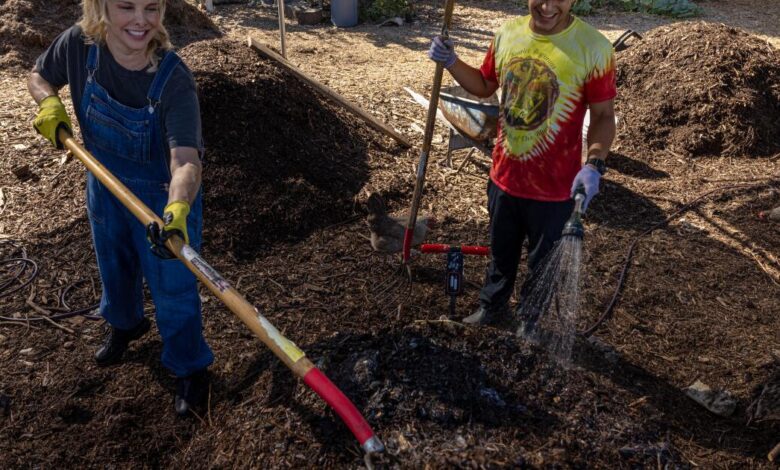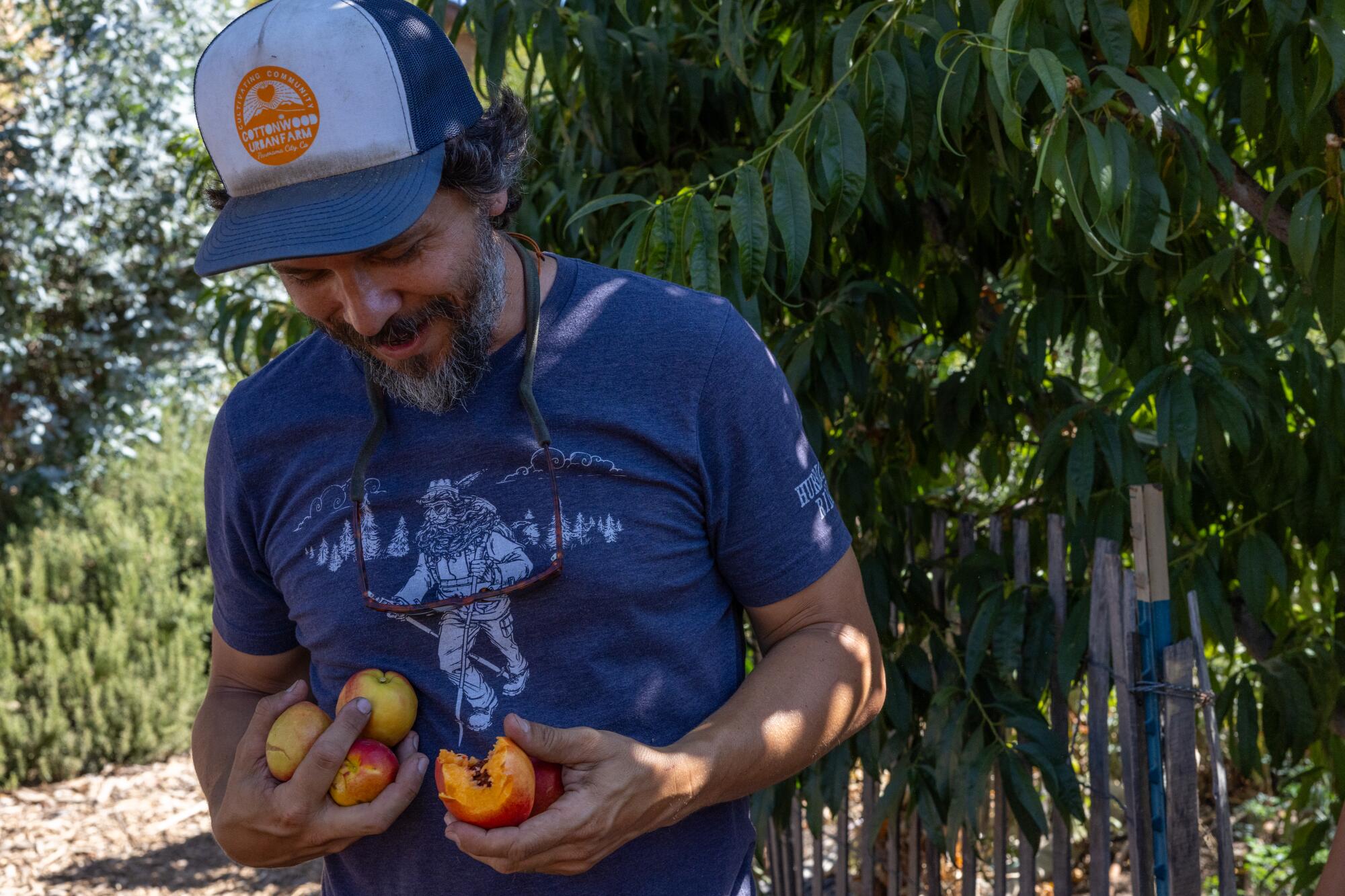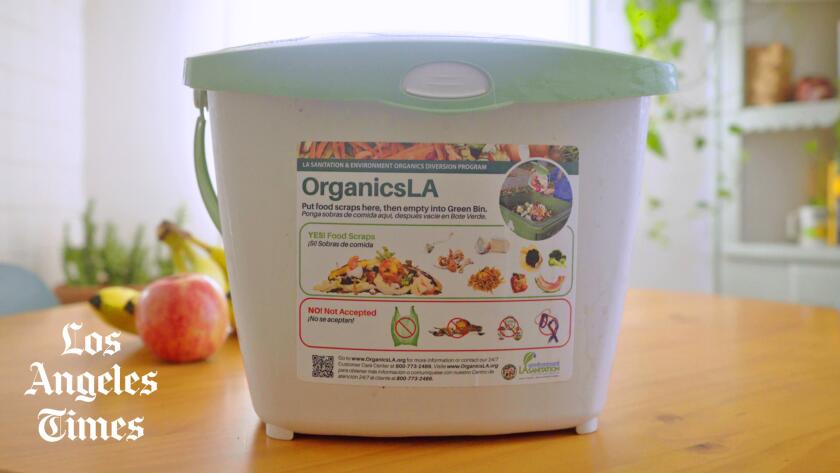Why is California slow to implement law to cut green waste, up composting

If tamping down Earth-warming greenhouse gases were as simple as separating coffee grounds, egg shells, leftover lasagna and other kitchen scraps from other waste, Californians certainly would be up to the task. Wouldn’t they?
That’s the assumption behind a groundbreaking state law that took effect at the start of 2022: that the state’s residents and businesses can redirect at least three-fourths of the organic waste once destined for landfills, where it would decompose into methane, a super-potent gas that traps up to 84 times as much heat as carbon dioxide.
But after 18 months under the new law, California has made uneven progress toward that goal. While most cities and counties have complied with the law, 126 asked for more time. And many people who live in apartments and condominiums, in particular, have not been offered the green-bin option that would allow them to recycle compost-worthy items at home.
Projecting that California would fall well short of its goal of removing 75% of green waste from landfills by 2025, the state’s Little Hoover Commission in June recommended a “temporary pause” in implementing the law. The good-government agency said more time is needed to fine-tune regulations, provide more funding for green waste facilities and launch a statewide education campaign.
But the Legislature has shown no signs of ordering a slowdown, and the top state official overseeing the reform said easing the pace would be counterproductive.
“What we really need is this cultural shift of moving away from a disposable lifestyle,” said Rachel Machi Wagoner, director of CalRecycle, “and really recognizing — from the manufacturer on through to the consumer at the point of use — the total value of any product and considering its next life.”

Sandra Torres brings bags of food scraps for composting at LA Compost.
(Irfan Khan / Los Angeles Times)
CalRecycle has worked cooperatively with local governments, which either haul green waste or contract with private companies to do the work. CalRecycle reports that most cities, counties and special districts are making adequate progress, but a review is underway to zero in on those that need to do more.
Wagoner said she remains confident that, once proper systems are in place, the environmentally minded state will happily redirect kitchen scraps and yard waste to separate containers.
The organic material is hauled to facilities that either turn the material into compost, mulch or bio-gases that can help power natural gas vehicles.
“You don’t have to go out and buy an electric vehicle to fight climate change, though that is a great thing,” Wagoner said. “The single fastest and easiest thing that Californians can do is take a banana peel, or watermelon rinds and chicken bones, and put them in their green bin. Then they’ve already had a huge impact on climate change.”
Experts describe the benefits of compost as exponential. It not only cuts methane emissions but returns nutrients to the soil, allows the ground to hold precious moisture and abets the “sinking” of Earth-warming carbon dioxide into the soil.
Scientists estimate that 20% of the methane plaguing California comes from landfills. If the state can reach its organic waste reduction goals, it would have a benefit equivalent to taking 3 million cars off the road, according to CalRecycle.
Those potential improvements inspired the California Legislature in 2016 to approve Senate Bill 1383, requiring all residents and businesses to separate “green” waste. The law went into effect on Jan. 1 of last year.
CalRecycle officials have stressed that they want to use friendly persuasion to get cities and counties to comply. But the law allows fines of up to $10,000 a day for those that fail. Local governments have the power, in turn, to fine residents and businesses that don’t segregate kitchen and yard waste from landfill-bound garbage. Penalties can range from $50 to $100 for a first offense and increase up to $500 for third and subsequent failures.
City officials have said they are loath to penalize residents and business owners. No fines have been levied so far — or at least none have been reported publicly.

If the state can reach its organic waste reduction goals, it would have a benefit equivalent to taking 3 million cars off the road, according to CalRecycle.
(Irfan Khan / Los Angeles Times)
The city of Los Angeles has OKd all those who live in single-family and small multi-family residences to dump their kitchen scraps in green bins picked up at curbside. That’s a total of 750,000 customers. More than 10,000 other commercial and multi-family customers have signed up for the service.
But that leaves 24,400 multifamily properties — with an untold number of apartments and condominium units — that have not signed up for curbside service.
L.A. lags behind environmental leaders such as San Francisco but is ahead of many other cities. In Long Beach, for example, a spokeswoman said residential collection of organic waste is not expected to start until late this year or in early 2024.
“We don’t need anything else going in landfills that are overflowing already. The greenhouse gases are such a big problem,” said Rose, a thirty-something who lives in the San Fernando Valley community of North Hills.

Elliott Kuhn, owner and director of Cottonwood Urban Farm, leases land to LA Compost and Black Thumb Farm.
(Irfan Khan / Los Angeles Times)
But Rose said other residents in her 21-unit condo complex have resisted. Members of the homeowner’s association said they don’t want to pay the added fees — likely at least $10 a month per unit — that accompany the service.
“I also don’t get the sense that a lot of them are thinking that much about the environment or climate change,” said Rose, who used her middle name to avoid touching off a feud with her neighbors.

Alexys Romo, founder of Black Thumb, who uses compost from LA Compost, picks fresh vegetables and fruits at Cottonwood Urban Farm in Panorama City.
(Irfan Khan / Los Angeles Times)
Community gardens and farmers markets provide other alternatives for people like Rose, who works for an environmental group.
L.A. Compost offers green waste dropoff at nine farmers markets in the city: Atwater Village, Central Avenue, Crenshaw, Highland Park, Larchmont Village, L.A. River, Silver Lake, Playa Vista and Wellington Square Farmers’ Market. Elysian Valley also has a food scrap collection site.
The nonprofit also offers small amounts of finished compost four times a year, and more regular compost for members of its Co-ops.
A better solution would be not creating green waste in the first place.
The state and the U.S. Environmental Protection Agency encourage “source reduction” — growing, buying and consuming only what is needed, so food doesn’t get thrown out in the first place. California’s law also required that big providers, such as supermarkets and cafeterias, preserve surplus food for distribution to those in need, often via food banks. That resulted in 116,000 tons of unsold food being diverted in the first six months of last year, on track to meet the 2025 goal for saving surplus food.
“We’re feeding people. And that food never needs to be recycled,” Wagoner said. “That’s very exciting.”







